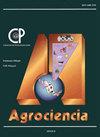GREEN MANURE AS A SOIL FERTILITY AND ENVIRONMENTAL OPTION IN SEMIARID AGROSYSTEMS: MINERALIZATION RATE AND N CONTENT
IF 0.5
4区 农林科学
Q4 AGRICULTURE, MULTIDISCIPLINARY
引用次数: 0
Abstract
Green manures are an adequate alternative for improving the availability of nitrogen and phosphorus for crop nutrition, within a global context of decreasing soil fertility and the urgent need to care for the environment. Mixteca region, covers a wide area of central Mexico, characterized by a semi-arid climate, eroded calcareous soil, and rural poverty. With the aim of proposing technologies for improving soil quality and increasing the availability of nitrogen and phosphorus, an experiment was conducted using green manures: Canavalia ensiformis, Dolichos lablab, Leucaena leucocephala and Avena strigosa and Phaseolus vulgaris, that would ensure a balance between N and P release and the requirements of maize cultivation. The rate of enriched soil mineralization with green manures was determined through incubation, controlled for 15 days with CO2 emissions using an OxiTop OC110® kit as an indicator of decomposition. CO2 emissions were greatest in the soil established with Leucaena leucocephala and least in the soil with no fertilizer, with emissions descending in the following order: Leucaena leucocephala > Canavalia ensiformis > Avena strigosa +Phaseolus vulgaris > Dolichos lablab > soil without green manure. It is assumed that a greater flow of CO2 is accompanied by greater mineralization and release of nutrients. The Ntotal in the soil treated with green manures was similar and greater than that of the soil without fertilizer. Soil treated with Avena strigosa+Phaseolus vulgaris contained the highest values of Nmineral (N-ammonium + N-nitrate). POlsen content in soils with green manures was double that of the soil without fertilizer. Incubation provided the opportunity of identifying those green manures with higher agronomic potential in the area under study. The biomass comprising Leucaena leucocephala leaves and tender stems constitute an alternative for improving soil by providing OM. However, when considering the availability of N and P, the Avena strigosa+Phaseolus vulgaris combination is a superior alternative for meeting the needs of maize cultivation.绿肥作为半干旱农业系统土壤肥力和环境选择:矿化率和氮含量
在全球土壤肥力下降和迫切需要保护环境的背景下,绿色肥料是改善作物营养氮和磷供应的适当替代办法。米克斯特卡地区,覆盖了墨西哥中部的广大地区,以半干旱气候、侵蚀的钙质土壤和农村贫困为特征。为了提出改善土壤质量和提高氮磷素有效性的技术方案,采用绿肥Canavalia ensiformis、Dolichos lablab、Leucaena Leucaena leucocephala、Avena strigosa和Phaseolus vulgaris进行了氮磷释放与玉米种植需求平衡的试验研究。利用OxiTop OC110®试剂盒作为分解指标,在二氧化碳排放的条件下,通过孵育15天来测定绿色肥料富集土壤的矿化率。CO2排放量以添加银合欢的土壤最大,不施肥的土壤最小,排放顺序为:银合欢>菜花>花楸+菜花>青花>未施用绿肥的土壤。据推测,更大的二氧化碳流量伴随着更大的矿化和养分的释放。绿肥处理土壤的全氮含量与未施肥土壤相近,且大于未施肥土壤。柠条+菜豆处理土壤氮素(n -铵态氮+ n -硝态氮)含量最高。施绿肥土壤的花粉含量是未施绿肥土壤的两倍。孵化提供了在研究地区识别具有较高农艺潜力的绿色肥料的机会。由银合欢叶片和嫩茎组成的生物量是通过提供OM改善土壤的替代方案。但从氮磷有效性考虑,腐草+菜豆组合是满足玉米种植需求的较优选择。
本文章由计算机程序翻译,如有差异,请以英文原文为准。
求助全文
约1分钟内获得全文
求助全文
来源期刊

Agrociencia
农林科学-农业综合
CiteScore
0.50
自引率
33.30%
发文量
51
审稿时长
18-36 weeks
期刊介绍:
AGROCIENCIA is a scientific journal created and sponsored by the Colegio de Postgraduados. Its main objective is the publication and diffusion of agricultural, animal and forestry sciences research results from mexican and foreign scientists. All contributions are peer reviewed. Starting in the year 2000, AGROCIENCIA became a bimonthly and fully bilingual journal (Spanish and English versions in the same issue). Since 2007 appears every month and a half (eight issues per year). In addition to the printed issues, the full content is available in electronic format.
 求助内容:
求助内容: 应助结果提醒方式:
应助结果提醒方式:


